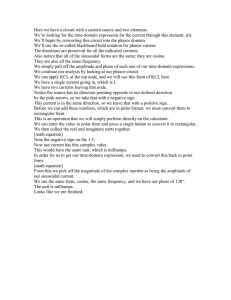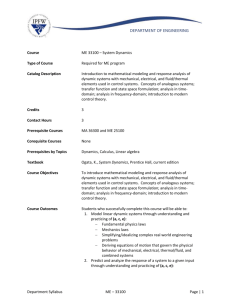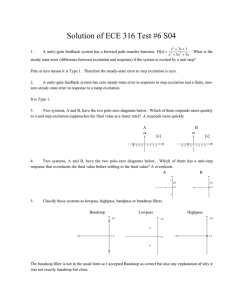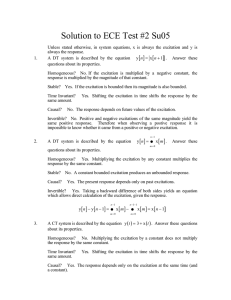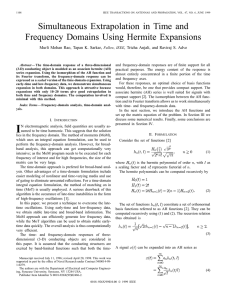Linear Systems
advertisement
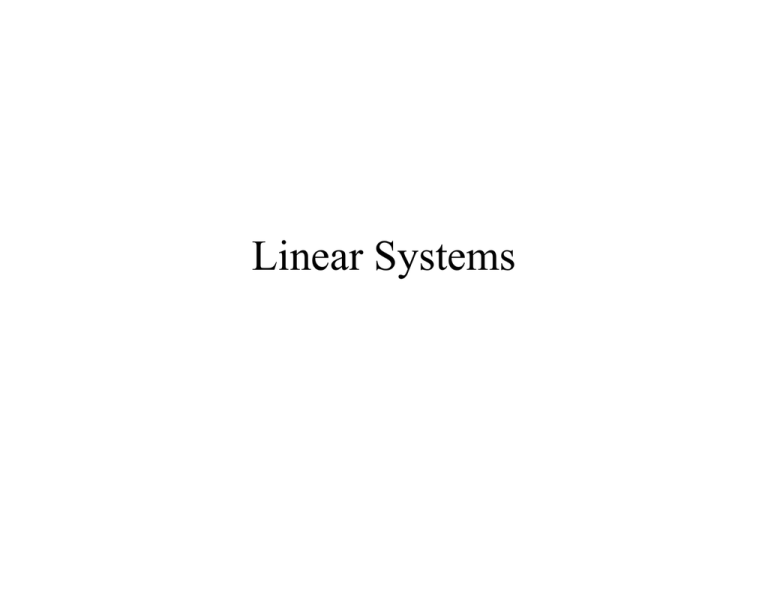
Linear Systems Time-Domain Analysis For any linear, time-invariant (LTI) system, the response y is the convolution of the excitation x with the impulse response h. () () () y t = x t ∗ h t or y ⎡⎣ n ⎤⎦ = x ⎡⎣ n ⎤⎦ ∗ h ⎡⎣ n ⎤⎦ In the case of non-deterministic random processes this operation cannot be done because the signals are random and cannot, therefore, be described mathematically. () () If X t excites a system and Y t is the response then the convolution integral is ∞ ( ) ∫ X (t − τ ) h (τ ) dτ Y t = −∞ Time-Domain Analysis We cannot directly evaluate ∞ ( ) ∫ X (t − τ ) h (τ ) dτ Y t = −∞ but we can find the expected value. ⎛∞ ⎞ E Y t = E ⎜ ∫ X t − τ h τ dτ ⎟ ⎝ −∞ ⎠ ( ( )) ( ) () If the stochastic process is bounded and the system is stable ∞ ( ( )) ∫ E ( X (t − τ )) h (τ ) dτ E Y t = −∞ Time-Domain Analysis If the random process X is stationary ∞ ∞ −∞ −∞ ( ( )) ∫ E ( X (t − τ )) h (τ ) dτ ⇒ E ( Y ) = E ( X ) ∫ h (τ ) dτ E Y t = Using ∞ ∫ h (t ) dt = H (0) ⇒ E (Y ) = E ( X ) H (0) −∞ where H is the Fourier transform of h, we see that the expected value of the response is the expected value of the excitation multiplied by the zero-frequency response of the system. If the system is DT the corresponding result is ( ) ∞ ( ) ∑ h ⎡⎣ n ⎤⎦ E Y =E X n= −∞ Time-Domain Analysis It can be shown (and is in the text) that the autocorrelation of the excitation and the autocorrelation of the response are related by () () () ( ) R Y τ = R X τ ∗ h τ ∗ h −τ or R Y ⎡⎣ m ⎤⎦ = R X ⎡⎣ m ⎤⎦ ∗ h ⎡⎣ m ⎤⎦ ∗ h ⎡⎣ −m ⎤⎦ This result leads to a way of thinking about the analysis of LTI systems with random excitation. Time-Domain Analysis It can be shown (and is in the text) that the cross correlation between the excitation and the response is () () () () () ( ) R XY τ = R X τ ∗ h τ or R XY ⎡⎣ m ⎤⎦ = R X ⎡⎣ m ⎤⎦ ∗ h ⎡⎣ m ⎤⎦ and R YX τ = R X τ ∗ h −τ or R YX ⎡⎣ m ⎤⎦ = R X ⎡⎣ m ⎤⎦ ∗ h ⎡⎣ −m ⎤⎦ Frequency-Domain Analysis The frequency-domain relationship between excitation and response of an LTI system is the Fourier transform of the time-domain relationship. () () () ( ) ( ) ( ) ( ) ( f ) = G ( f ) H( f ) (F) = G (F)H(F)H (F) = G (F) H(F) R Y τ = R X τ ∗ h τ ∗ h −τ ←⎯→ G Y f = G X f H f H F F R Y ⎡⎣ m ⎤⎦ = R X ⎡⎣ m ⎤⎦ ∗ h ⎡⎣ m ⎤⎦ ∗ h ⎡⎣ −m ⎤⎦ ←⎯ →GY The mean-squared value of the response is ∞ X ∞ 2 Y ( ) E Y 2 ∞ = 2 df −∞ ( ) ∫ G Y F dF = −∞ X X −∞ ∞ ( ) ( ) ∫ GX F H F −∞ X * ( ) = ∫ G ( f ) df = ∫ G ( f ) H ( f ) E Y 2 * 2 dF 2 Frequency-Domain Analysis Frequency-Domain Analysis Equivalent Noise Bandwidth
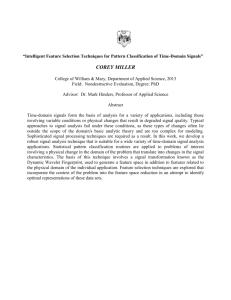
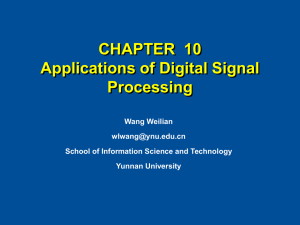
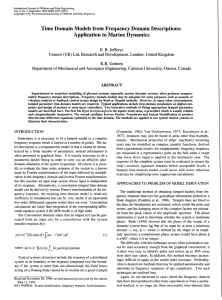
![Solution to Test #4 ECE 315 F02 [ ] [ ]](http://s2.studylib.net/store/data/011925609_1-1dc8aec0de0e59a19c055b4c6e74580e-300x300.png)

